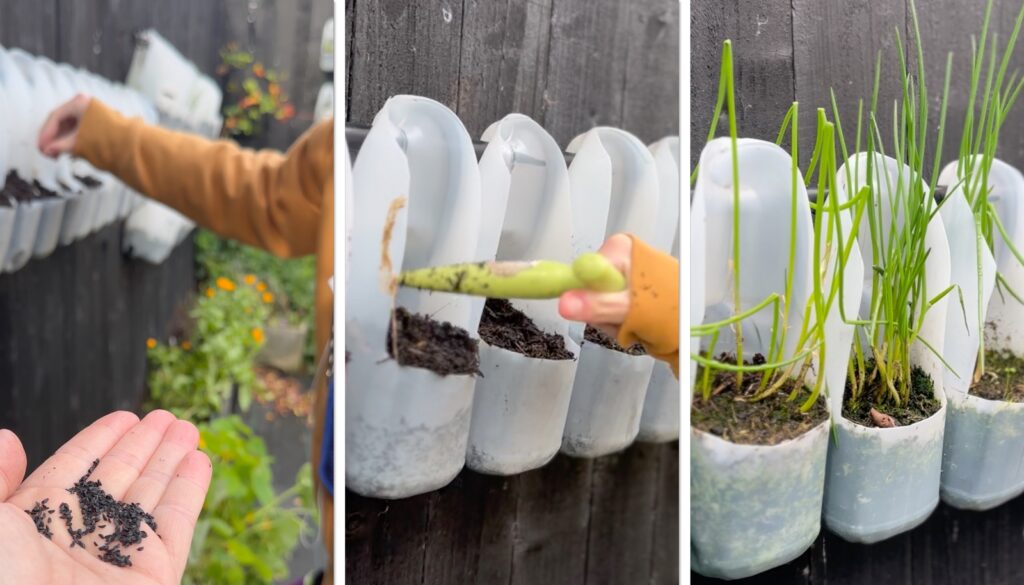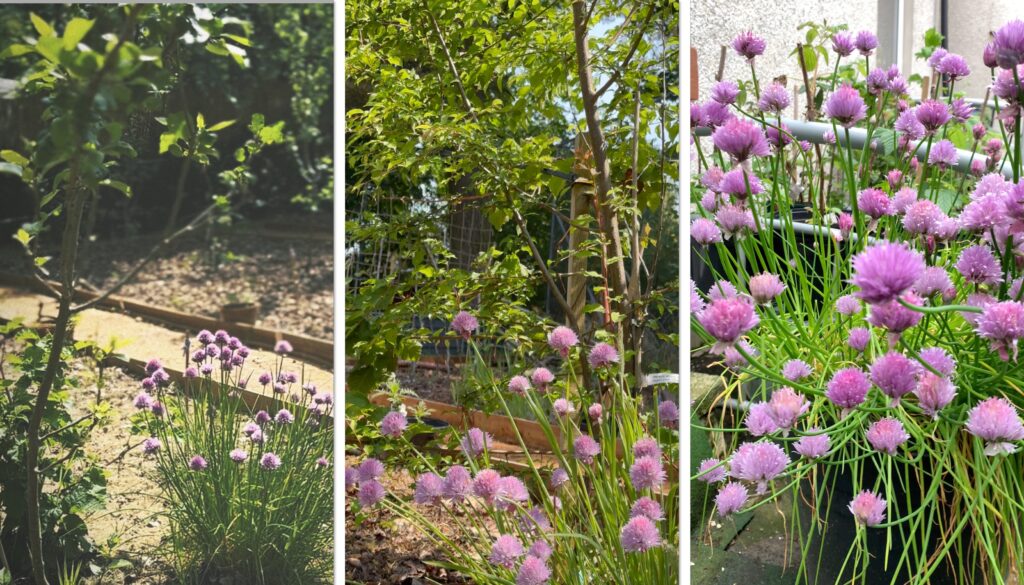Guest post by Katrina & Clayton
Chives are a versatile and hardy addition to any garden. The mild onion flavour and vibrant purple blooms make them a favourite among chefs and gardeners alike. We’ll look into growing chives in the Scottish climate, covering everything from planting to care tips along with the optimal soil conditions for each stage of their growth.
Growing Chives In Scotland
Chives (Allium schoenoprasum) are among the easiest herbs to grow in Scotland, making them an ideal choice for both novice and seasoned gardeners alike. These perennial plants belong to the onion family and are characterised by their slender, hollow leaves and spherical purple flowers.
Every bit of the chives are edible, the green stalks to the purple blooms. Infuse them into oils or vinegars for a subtle onion flavour that can elevate any dish, or simple cut the stems or flowers up and add them to your meal.
To start growing chives, select a sunny spot in your garden that receives at least six hours of sunlight daily. While chives can tolerate partial shade, they thrive in full sun. Ensure that the soil is well-drained and fertile, as chives prefer moderately rich soil with a pH level between 6.0 and 7.0. Adding in some Caledonian Topsoil to help with fertility would be ideal.
Planting Chives
Planting chives in Scotland typically occurs in early spring, once the soil has warmed and the threat of frost has passed. However, we plant our seeds all year round and over winter them in our vertical garden, they are very hardy plants. To grow you can propagate chives from seeds or divide existing plants.
Planting From Seed
If planting from seeds, we find you do not need to be too careful with them, they are such tiny seeds and you’ll want clumps of them to plant out rather than single stems so sprinkling 5-10 seeds in pots works just fine.
Make a hole in your pot
Sprinkle your seeds in
Give a good water in
As soon as they sprout, water once a week until large enough to plant out, over 5” tall. You can start these indoors on a windowsill or outdoors. If outdoors in the winter months, they will stay dormant until the weather warms up and they’ll start to appear.

Clayton & I planting out seeds in our vertical growing space, milk cartons on a fence.
Dividing Chives
Dividing chives is an essential aspect of their care, as it prevents overcrowding and rejuvenates older plants. In Scotland, dividing chives is typically done in early spring or early autumn, when the plants are dormant or just beginning to emerge from dormancy.
Using a spade or garden fork dig around the chives you want to divide making sure you dig deep enough to not cut off the roots
Carefully lift the clump of chives
Separate it into smaller sections
Replant the divisions in prepared soil
To divide either give them a gentle tug and wiggle to pull the roots apart, or use your spade to dig into the roots to separate into smaller sections. Give the new plant clumps good spacing to grow on, add some Caledonian Topsoil in and around the new hole for them to thrive.

Clayton dividing a large chives plant to produce more and move around the garden.
Pruning Chives
Pruning chives is a straightforward task that helps promote healthy growth and prevents them from becoming overly leggy. Throughout the growing season, trim the leaves as needed, using kitchen scissors or gardening shears. Avoid cutting more than one-third of the foliage at once, as this can weaken the plant.
Regular pruning encourages new growth and ensures a steady supply of fresh chives for culinary use. After flowering, to keep chives looking neat, remove the faded heads, cutting and removing the tough, inedible flower stalks right at the base. Chives require very little maintenance, but give them the occasional chop, right down to the ground and you’ll be harvesting leaves and flowers right through the summer. If you have a large supply of chives, chop them up with kitchen scissors and freeze them in a tub or bag, ready to be used all year round.

Cutting some chives to chop with kitchen scissors and freeze.
Caring For Chives
While chives are relatively drought-tolerant once established, they benefit from regular watering, especially during dry spells. However, be cautious not to overwater, as excessive moisture can lead to root rot.
Chives generally do not require heavy feeding. Mulching around the base of chive plants can help conserve soil moisture and suppress weed growth. You could add some Caledonian Green Goodness to mulch with.
Companion Planting with Chives
Chives are excellent companions for a variety of plants in the Scottish garden, thanks to their pest-repelling properties and beneficial effects on neighbouring crops. Planting chives alongside vegetables such as carrots, tomatoes, and peppers can help deter aphids, carrot flies, and other common garden pests. Their aromatic foliage also attracts beneficial insects like hoverflies and lacewings, which prey on aphids and other harmful pests. We plant these next to everything we plant out, they deter the deer and slugs with the strong smell.

Growing Chives under our fruit trees and grown in a tub in the kitchen courtyard garden.
Optimal Soil Conditions
Chives thrive in well drained soil, so when planting in ground, make sure it isn’t a water logged area.
For Container Grown
Ensure that the containers have drainage holes to prevent waterlogging, especially in Scotland’s wet climate. You can place some stones at the bottom of any pots to allow any excess water to drain quickly.
Enjoy the simplicity of growing these resilient herbs and produce a steady supply of fresh chives for your favourite dishes all year round, while keeping those garden pests at bay.
Katrina & Clayton

Katrina & Clayton live with their family in East Ayrshire in Scotland and share their daily life in the garden on instagram @buildingfoodforest_scotland. They practice permaculture principles, reducing & repurposing waste whenever they can. Katrina shows how home educating in nature has helped Clayton thrive.
Clayton Completed The Grow and Learn Course with the Royal Caledonian Horticultural Society in 2022. This year he will be completing Level 2 Nurture Course. Clayton is 16, Autistic, Non Verbal & has been Home Educated for the last 6yrs. Both Katrina and husband Peter have studied the Permaculture Design Course PDC and PDC Pro over the last 5yrs, developing their garden from grass to an ongoing food forest.
They have featured on BBC Beechgrove Gardens, Gardeners World Magazine and write for Scotland Grows Magazine. Katrina has a series of children’s story books out following the life of Clayton in the garden. Available at Amazon.
See more and follow Katrina & Clayton at the links below:
-
 Builder’s Bag Green Goodness£52.00 inc VAT
Builder’s Bag Green Goodness£52.00 inc VAT -
 Builder’s Bag Topsoil£68.00 inc VAT
Builder’s Bag Topsoil£68.00 inc VAT -
 20kg Caledonian Topsoil£3.50 – £4.50 inc VAT
20kg Caledonian Topsoil£3.50 – £4.50 inc VAT

